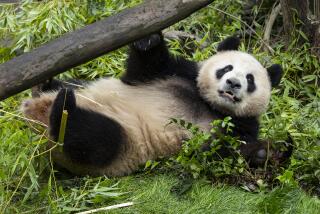Call of the Wild : Pet Parrots on the Loose Grow in Number
- Share via
The hum of traffic is broken by a sharp squawk that sounds as if it’s straight out of the jungle.
And high up in the air, its wings flapping in short, fast beats, a bright-green parrot with a blazing yellow head swoops through the haze of the San Gabriel Valley.
Yes, a wild parrot, flying free in search of food.
Amazon parrots native to Mexico and Central America are being sighted in increasing numbers in the San Gabriel Valley, as well as on the Westside and in the San Fernando Valley. They’re generally in flight near areas of lush vegetation where the birds nest and feed.
No one knows for sure how many of the feral fowl live in Southern California, but bird experts estimated there may be close to 1,000. And the number is growing.
Kimball Garrett, ornithology collections manager for the Natural History Museum of Los Angeles County, said the birds, many of which have escaped from captivity over the years, have been breeding in the wild and may have established a significant population of parrots that never has lived in cages.
Ironically, the number of wild parrots in their native habitats is dwindling because the heavy forest they call home is rapidly being cleared. And they are being caught for export as pets.
The birds can range in price from $20 to $9,000 in pet shops. Yellow-headed parrots, among the most common species in Southern California, cost between $500 and $1,000, said Lloyd Bremseth, owner of Birds Plus in Van Nuys.
The tales of how the parrots ended up in Los Angeles differ.
Some speculate that the birds escaped when the roof of an aviary was destroyed. Others say it was a pet shop fire about two decades ago that sent dozens of parrots fluttering into the wild. And bird-watchers say smugglers will sometimes liberate their shipments when faced with arrest.
In the San Fernando Valley, some suspect that the birds are escapees from the old Busch Gardens at the Anheuser-Busch brewery in Van Nuys. And hundreds may have escaped from private owners’ cages, possibly working their way through the bars with their powerful beaks.
Garrett said those stories may or may not be true, adding that the current population cannot be traced to one or two isolated releases. “It’s the result of unintentional and intentional releases over the years,” he said.
Little research has been done on the parrots. And although the birds are extremely social among themselves, sometimes squawking to each other at all hours of the night, they are reclusive around humans. Few of even the most avid bird-watchers have found nests or seen the birds doing anything except zipping overhead.
“I hear them more than I see them,” said Millie Newton, executive secretary of the Los Angeles Audubon Society.
Seventy years ago, the parrots would not have survived in Southern California’s dry climate, let alone thrived. But the suburban passion for lush landscaping has created an environment hospitable to the parrots, which feed on fruit and nuts.
Garrett said several species make their nests in palm fronds.
Some species of exotic birds were eradicated several years ago by state agriculture officials because they devoured crops in Southern California. Garrett said, however, that the parrots have posed no significant threat to what agriculture remains in the area and they appear to have little or no harmful effect on native birds.
But Bremseth saw a down side to having the birds become more common. “If people can see parrots in their back yard, why would they want to buy one from me?”
More to Read
Sign up for Essential California
The most important California stories and recommendations in your inbox every morning.
You may occasionally receive promotional content from the Los Angeles Times.













